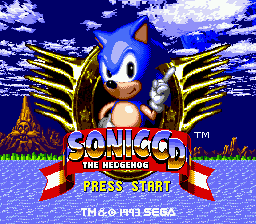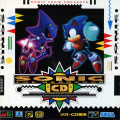Sonic the Hedgehog CD
From Sonic Retro
Revision as of 11:19, 3 June 2008 by Ss is testing (talk | contribs)
| Sonic the Hedgehog CD |
|---|
| System(s): Sega Mega CD, Windows PC |
| Publisher: Sega |
| Developer: Sega |
| Genre: 2D Platform |
Sonic the Hedgehog CD or Sonic CD (as it is known in Europe and North America) is a video game that is still well acclaimed by Sonic fans. The game was never touched by Yuji Naka himself, but instead was helmed by Sonic creator Naoto Ohshima, which explains why the theme of the game is different.
Sonic the Hedgehog is chasing Metal Sonic, who kidnapped a girl named Amy Rose. Amy has a much different style in this game than she does today. It turns out that Amy had used the tarot cards to find Sonic, but was kidnapped in front of his very eyes. Sonic has to get the Time Stones and to travel through time to foil Dr. Robotnik's (Doctor Eggman in the Japanese version) latest plot.
The game's key element was the manner in which the player could travel to 4 different versions of each level in 3 different time periods. This was accomplished by speed posts scattered around the level, saying "Past", and "Future". There were never "Past" signs in the Past and never "Future" signs in the Future. If you destroyed a special machine in the past, then you traveled to the future it would be the different "Good Future" with no enemies. You would receive the good ending to the game by completing all the good futures or by collecting the 7 Time Stones in the Special Stages.
The game itself has Sonic feeling generally more sluggish than normal. The spin dash he does is different to that of Sonic 2's; the position he takes in both games is different. A new move was added to complement the spin dash: the Super Peelout. The Super Peelout, performed in a manner much the reverse of the spin dash, by pressing up and any trigger button, causes Sonic to rev in position until you release the button, at which point he speeds off. The difference between the spindash and the Super Peelout is the spindash damages enemies who get in its way, due to Sonic's curled attacking pose; the Super Peelout, whilst faster than the spindash, does no damage, instead leaving Sonic vulnerable to attack.
Also, while leaving the game idle for more than a few seconds made Sonic tap his foot impatiently, as per usual, leaving the game for 3 minutes caused Sonic (i.e. a digitized voice clip) to say "I'm outta here!", followed by Sonic jumping off the screen and the player receiving a Game Over.
Contents
Development
After the release of Sonic the Hedgehog, creator Yuji Naka had grown dissatisfied with the rigid corporate policies at Sega, so he moved to America to work with the Sega Technical Institute. Incidentally, a large number of the original design team of Sonic also left for America, to help instructing the American developers. With half of Sonic Team and two of its most important creators present, the Sega Technical Institute eventually got the job to develop Sonic the Hedgehog 2.
Meanwhile in Japan, Sonic CD was handled by a separate development team, headed by Sonic creator Naoto Ohshima. As both Sonic CD and Sonic 2 were developed independently from each other, each game took a different direction from Sonic 1. Eventually the gameplay of Sonic 2 would be favoured for the future games but this explains why the theme and handling of Sonic CD are different, as well as the use of Sonic 1's sprites for Sonic. The time posts also had pseudo-3D sprites similar to the Knuckles' Chaotix title screen.
Sonic CD was released after Sonic the Hedgehog 2 but before Sonic the Hedgehog 3. However, since Sonic 3 takes place where Sonic 2 left off, some fans believe the story of Sonic CD either takes place before Sonic 2 or after Sonic & Knuckles.
The US Version
The most controversial fact about this game is that the US and Japanese versions feature two different soundtracks. Europe uses the Japanese soundtrack. The Japanese soundtrack was composed by Naofumi Hataya and Masafumi Ogata, and featured songs by Keiko Utoku. The songs were entitled "Sonic - You Can Do Anything" (infamously nicknamed "Toot Toot Sonic Warrior" by Sonic fans) and "Cosmic Eternity".
The US version was delayed a few months to have a new soundtrack composed by Spencer Nilsen, who did other Sega CD soundtracks as well as some early Sega Saturn soundtracks. All the music (save for the Past tunes, which were in PCM audio rather than Red Book CD Audio) was replaced, and new themes were composed. The new theme was "Sonic Boom", performed by Pastiche. Both the opening and ending had similar lyrics but different instrumentation. Every re-release of the game in the US exclusively has this soundtrack, including both the PC version and the one in Sonic Gems Collection (the latter having the American soundtrack even in Europe); the Japanese soundtrack surfaced in Sonic Screensaver, but otherwise has never made it to the States.
Sonic fans are usually split between the music of each game. Some prefer Hataya and Ogata's music, others prefer Nilsen's music, some like both equally.
The US version also replaced Amy Rose's name in the manual with that of Princess Sally to garner support for the television show, despite the fact that the Princess Sally character was already established.
Ports
A version available for the personal computer was released in Japan on August 9, 1996, with a North American version in August 26, 1996, and a European version in October 3, 1996. Among the most noteworthy changes of this version was the fact that the entire FMV anime intro and ending sequence is available for this version. The Mega-CD version only had a truncated version of the intro and ending sequence. The Japanese version of the game had its manual translated from the US version, and all versions had the US soundtrack, with the "Past" tunes converted to normal CD tracks. Also on the disc is a short video clip of a pencil sketch of Sonic in action. Unfortunately, the PC version is not compatible with Windows XP or Windows Vista without the use of a homebrewed patch created by Korama ([1]).
In addition to the PC port, a modified version of it is part of the Nintendo GameCube (and, in Japan and Europe, PlayStation 2) compilation Sonic Gems Collection. The soundtrack in this version depends on the region, however in Europe it uses the American soundtrack instead of Japanese one. Also there's a new bug where water in one of the zones appears clear instead of green, possibly related to the Windows compatibility problems.
Manuals
- Sonic CD US Manual
- Sonic CD JP Manual
- Sonic CD EU Manual
- Sonic CD (PC) US Manual
- Sonic CD (PC) JP Manual
Beta Info
Sonic CD is one of the few games out that has had multiple betas recovered. Three to be more precise:
Also Released On
- Sonic Gems Collection for the Nintendo GameCube and Sony Playstation 2 (2005)
Production Credits
Executive Producer: Hayao Nakayama
Producers: Minoru Kanari, Makoto Oshitani
Director: Naoto Oshima
Program Director: Keiichi Yamamoto
Art Director: Hiroyuki Kawaguchi
Sound Director: Yukifumi Makino
Game Designers: Hiroaki Chino, Kenichi Ono, Yuichiro Yokoyama, Takao Miyoshi, Akira Nishino
Character Designer: Kazuyuki Hoshino
Landscape Designers: Hiroyuki Kawaguchi, Takumi Miyake, Masahiro Sanpei, Masato Nishimura, Hideaki Kurata
Special Stage Designers: Kazuyuki Hoshino, Judy Totoya
Special Stage Progammer: Keiichi Yamamoto
Animation Programmers: Yuichiro Mine, Eiji Horita
Animation Visual Directors: Hiroyuki Kawaguchi, Masahiro Sanpei
Visual Design: Kazuyuki Hoshino, Takumi Miyake
Chief Programmer: Matsuhide Mizoguchi
Programmers: Yuichi Matsuoka, Hiroshi Takei, Tatsuya Satoh, Noritaka Yakita
Sound Effects: Yukifumi Makino
Sound Programmer: Yukifumi Makino
Music (Original/JPN): Naofumi Hataya and Masafumi Ogata
Music (US): Spencer Nilsen, David Young
Special Thanks: Naofumi Hataya, Masafumi Ogata, Daisuke Saito, Hiroshi Kubota, Reiko Kodama, Yoshiaki Kashima, Takenobu Mitsuyoshi, Masaru Setsumaru, Hifiri Aoki, Stene Ray Burton, James Michael Spahn, Kounosuke Yoshio, Tomoko Saskai, Aki Kamta, Masato Nishimura, Fujio Minegishi, Jina Ishiwatari, Katsufumi Yoshimori, Tetsuo Akagi
, Kaeko Itoh, Hiromi Nakatani, Hiroshi Fukuda, Etsuko Yamada, Ryuichiro Kutsuzawa, Takashi Lwade, Michiazu Tamamura, Masumi Uchida, Toru Watanuki, Makiko Suzuki, Audix, Digital Support Group, Fairlight E.S.P, Opcode, Otari, Zoom
Resources
Original Sound Version Recordings
For the Windows version see Sonic_CD_for_Windows_95_OST for a download page. For the Japanese Sega CD version see Sonic CD (Japan & PAL Regions) OST.
Box Art
(Via Sonicology)
| Sonic the Hedgehog games for the following systems | |
|---|---|
| |
1991 Sonic the Hedgehog | Sonic Eraser 1992 Sonic the Hedgehog 2 1993 Sonic the Hedgehog CD | Dr. Robotnik's Mean Bean Machine | Sonic Spinball 1994 Sonic the Hedgehog 3 | Sonic & Knuckles 1995 Chaotix | Sonic Classics 1996 Sonic 3D: Flickies' Island |



